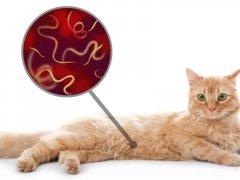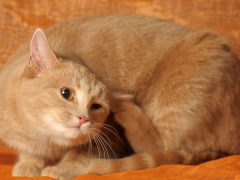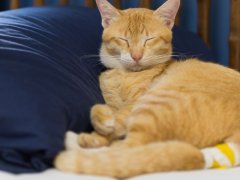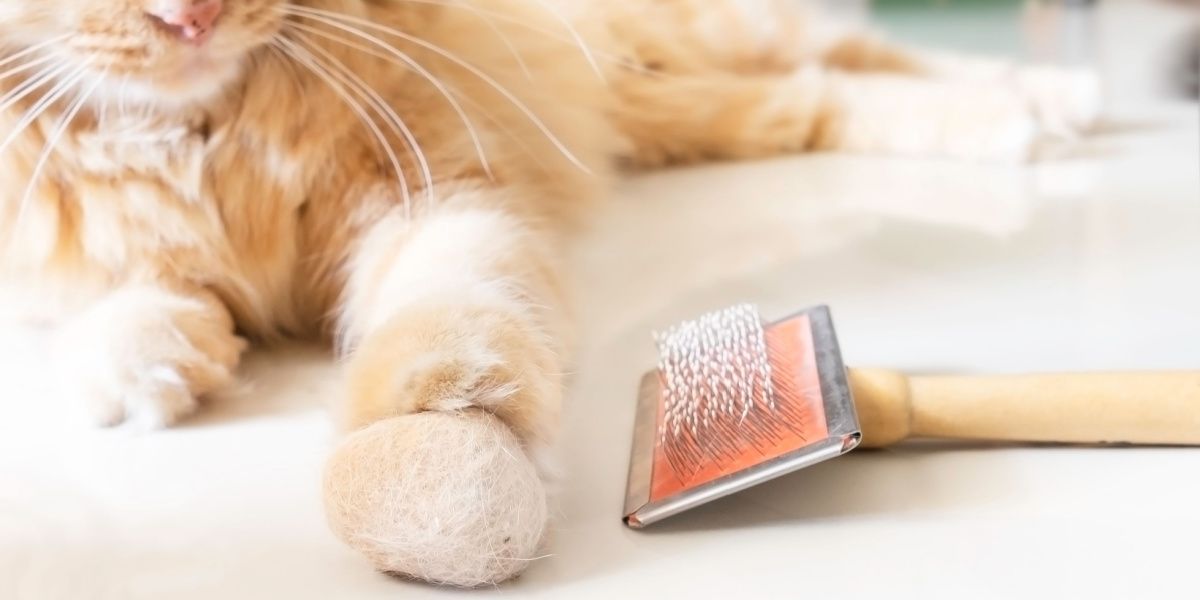
Note: Medical review of this article includes only the underlying medical information in this article. The veterinarian reviewing this article does not personally endorse, recommend, or vouch for the efficacy or claims of any products mentioned in this article.
Countless cat lovers have experienced the less-than-pleasant sensation of stepping barefoot onto a wet, furry, and sometimes still warm hairball left on the floor. Whether your cat has coughed up her first hairball or just one of many, it’s good to know what is and is not normal about cat hairballs.
What Are Cat Hairballs?
A cat hairball is one of those things that is exactly what it sounds like: a ball of hair, originating from a cat. The scientific name for hairballs is trichobezoar.
Hairballs occur when cats ingest their own hair while grooming themselves. Although hair should normally pass through the cat’s digestive tract (where it is eventually pooped out), sometimes hair remains inside the stomach.
This is due to either an excessive intake of hair or a decreased ability of the stomach and intestines to propel material through to the colon. Healthy cats do not vomit hairballs regularly.
Since hair cannot be digested, any hair that doesn’t pass out of the stomach and into the intestines balls up inside the stomach, where it remains until it is vomited up. If the cat does not expel a large hairball (either by vomiting it up or passing it through the digestive system and out of the body by defecating), it can cause a potentially life-threatening obstruction of the intestinal tract.
What Causes Cat Hairballs?
Cats ingest hair while grooming that should pass through their stomach and intestines without a problem. Some cats may develop recurrent or frequent hairballs for one of a few reasons.
- Recurrent hairballs are more commonly seen in certain longhaired cat breeds like Himalayans, Maine Coons, Norwegian Forest Cats, Persians, Ragdolls, and Siberians, or in any breed or mixed breed cats with a lot of hair.
- Hairballs can also be a problem in cats that obsessively over-groom themselves, which can be a symptom of anxiety, itchiness, pain, or a parasitic infestation (like fleas).
- Finally, some cats may develop recurrent hairballs if they have issues with gastrointestinal motility (the ability of the muscles of the stomach and intestines to move food and in this case, hair, through the digestive tract).
What Do Cat Hairballs Look Like?

Hairballs typically have a cylindrical, feces-like shape and usually come up with some clear or yellow liquid. If your cat’s eaten grass recently, grass or bits of undigested food may also come with the hairball.
Hairballs typically have a cylindrical, feces-like shape and usually come up with some clear or yellow liquid. You may or may not also see food or grass in the vomited hairball mass.
Cat hairballs all look different, but they are generally wet wads of hair, saturated with a clear or yellow liquid that might be foamy or slimy-looking. Although called hairballs, they are not always ball-shaped when your cat vomits them up.
The hair (which might have looked like a ball in the stomach) becomes stretched and compressed as it passes through the esophagus. For this reason, cat hairballs usually look like long, thin tubes of compacted hair. If there is a lot of liquid or food in the vomit, it may sometimes be difficult to see the wad of hair.
How Do You Know If Your Cat Has Hairballs?
The clearest sign that your cat has hairballs is finding one on the floor. Before coughing up a hairball, cats usually hunch down on the floor and make a dramatic hacking, coughing or gagging sound.
However, sometimes cats have hairballs that they are not able to vomit up. Hair trapped in the intestinal tract can cause serious problems, so it’s vital to have your cat seen by a veterinarian if you think she might have hairballs.
Some signs that a cat may have hairballs include:
- Vomiting with or without visible hair
- Not eating or eating less than usual
- Lethargy (lack of energy/lying around)
- Acting as if in pain
- Wads of hair visible in feces
Other Health Issues That Resemble Cat Hairballs
It can sometimes be difficult to tell if your cat has hairballs or another health condition. Two health issues that often mimic hairballs are asthma and vomiting (for reasons other than hairballs).
However, you can look for some clues to help you figure out what might be going on with your cat.
Cat Hairball Or Feline Asthma?
Cats suffering from an asthma attack will wheeze, which can look and sound very similar to the coughing and gagging sounds a cat makes when attempting to bring up a hairball. Diagnosis of asthma is often delayed by a cat owner thinking that an asthmatic cough is “just a hairball.”
It can be difficult to distinguish between a cat that is coughing and a cat that is vomiting up a hairball. During an asthma attack, a cat will often hunch down very low to the floor and stretch her head and neck out as she attempts to suck in more air.
If your cat is having regular episodes of coughing or vomiting, the best plan is to have her checked by your veterinarian. Finding the underlying cause for these symptoms (commonly with radiographs of the chest or abdomen) will help your veterinarian find the best strategy to keep your kitty as comfortable as possible.
Cat Hairball Or Vomit?
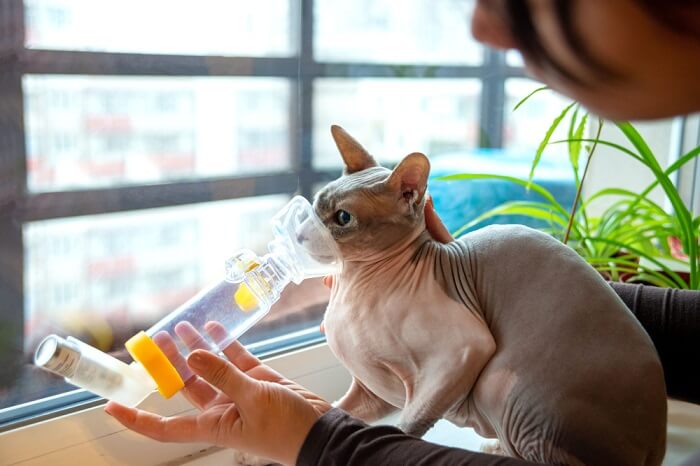
When a cat “coughs up” a hairball, she is in fact vomiting. However, cats can vomit for other reasons that don’t involve hairballs. Many cats that regularly bring up hairballs have an underlying intestinal motility problem like Inflammatory Bowel Disease (IBD).
Even if you see hair in your cat’s vomit, it may not be due to a hairball. On average, cats spend about 3.5 hours per day grooming, so there will often be some transient hair in their stomach. If your cat vomits and is acting ill (not eating, lethargic and/or also experiencing diarrhea) it might not be a simple hairball.
It’s also possible for a cat that does have a hairball in her stomach to vomit without producing any hair, so a lack of hair in the vomit is not always indicative of what’s causing the vomiting. If your cat experiences repeated vomiting, it always warrants a visit to the veterinarian to investigate the cause.
Cat Hairball Treatment
Regularly brushing your cat can help to reduce the amount of fur she ingests and hence, the incidence of hairballs. Long-haired cats that do not tolerate or benefit from brushing by their owners may benefit from regular clipping to reduce hair ingestion.
Treating hairballs consists of first addressing the current hairball your cat has, then making some lifestyle changes and additions to your cat’s diet to prevent future hairballs. A visit to your veterinarian can rule out any medical causes for the hairball, such as problems with gastrointestinal motility or a potential intestinal blockage.
With a blockage, the hairball passes through the stomach but becomes trapped in the intestines. This can be a life-threatening situation so it’s important to relieve the obstruction as soon as possible. In some cases, treatment consists of fluids and laxatives to help move the hairball along. In more severe cases, the hairball may need to be surgically removed by your veterinarian.
Since over-grooming or barbering (chewing hair short) will also contribute to the formation of hairballs, causes of these behaviors should be addressed if no problems with gastrointestinal motility are found. Your veterinarian may look for fleas, evidence of skin allergies, areas of pain, or a urinary tract infection.
After the current cause for hairballs has been addressed, your veterinarian may recommend some of the following lifestyle changes to help prevent hairball recurrence:
Oral Remedy For Cat Hairballs
Petroleum jelly hairball remedies like Laxatone may help to lubricate the hair so that it moves through the cat’s gastrointestinal tract more easily. Some cat owners prefer to use non-petroleum hairball remedies, which work similarly to petroleum-based products but are made with different kinds of lubricants. Consult your veterinarian before using these products since the addition of a non-soluble fat to a cat’s diet may affect absorption of certain vitamins.
Read More: Best Cat Hairball Remedies
Natural Remedies For Cat Hairballs
One of the most natural and simple ways to cut down on hairballs is to brush your cat often. The more loose hair you can brush out of your cat’s coat, the less she will ingest while self-grooming.
A de-shedding tool made for cats, like the FURminator, can be very helpful for cats with profuse undercoats. After brushing, a quick wipedown with a damp cloth can help to remove loosened hair before your cat grooms herself to fix your hairstyling misdeeds.
Read More: Best Cat Brushes and Deshedding Tools
Cat Food For Hairballs
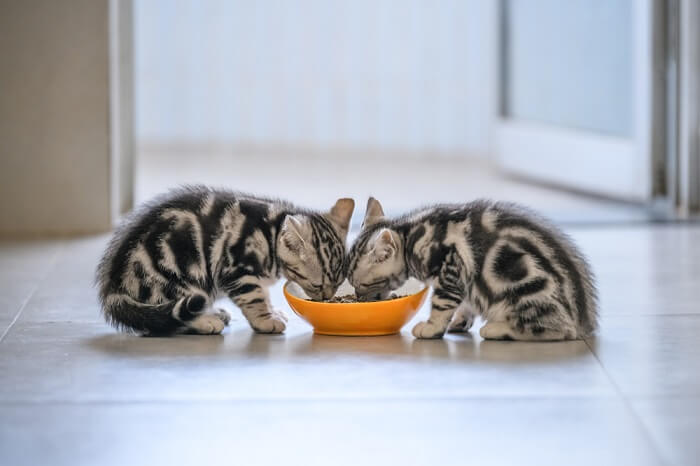
Some cat foods are specially formulated to help prevent hairballs. Such hairball prevention diets contain extra fiber and certain ingredients intended to lubricate the intestinal tract.
Always talk to your vet before switching your cat’s food and make diet changes gradually to avoid stomach upset.
Cat Treats For Hairballs
Similar to hairball prevention cat foods, special hairball prevention cat treats also contain added fiber and lubricating ingredients. Hairball prevention cat treats should be given according to the package directions, and like all treats, should make up no more than 10% of your cat’s total diet.
Don’t Ignore Cat Hairballs
Something to keep in mind: cat hairballs are not “normal.”
Although it is normal for a cat to ingest some hair while self-grooming, in a healthy cat, the hair should pass through the digestive tract and be expelled from the body in the stool. Cats that bring up hairballs more than once or twice a year should be examined by your veterinarian.
Cats that experience recurring hairballs require some lifestyle changes to reduce the incidence of hairballs or diagnostics to find the cause of the hairballs.
